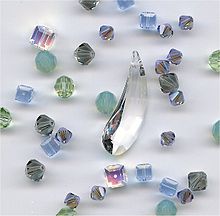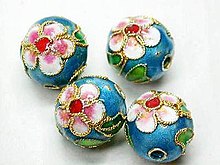News
First Post April 07 2014
Types of beads
Beads may be divided into several types of overlapping categories based on different criteria such as the materials from which they are made, the process used in their manufacturing, the place or period of origin, the patterns on their surface, or their general shape. In some cases, such as millefiori and cloisonné beads, multiple categories may overlap in an interdependent fashion.
Components
Beads can be made of many different materials. The earliest beads were made of a variety of natural materials which, after they were gathered, could be readily drilled and shaped. As humans became capable of obtaining and working with more difficult materials, those materials were added to the range of available substances. More recently, synthetic materials were added.
In modern manufacturing, the most common bead materials are wood, plastic, glass, metal, and stone.
Natural materials
Beads are still made from many naturally occurring materials, both organic (i.e., of animal- or plant-based origin) and inorganic (purely mineral origin). However, some of these materials now routinely undergo some extra processing beyond mere shaping and drilling such as color enhancement via dyes or irradiation.
The natural organics include bone, coral, horn, ivory, seeds (such as tagua nuts), animal shell, and wood. For most of human history pearls were the ultimate precious beads of natural origin because of their rarity; the modern pearl-culturing process has made them far more common. Amber and jet are also of natural organic origin although both are the result of partial fossilization.
The natural inorganics include various types of stones, ranging from gemstones to common minerals, and metals. Of the latter, only a few precious metals occur in pure forms, but other purified base metals may as well be placed in this category along with certain naturally occurring alloys such as electrum. There are also paper beads.
Synthetic materials
 Swarovski crystal beads (6 mm–8 mm), pendant 3 cm
Swarovski crystal beads (6 mm–8 mm), pendant 3 cm
The oldest-surviving synthetic materials used for beadmaking have generally been ceramics: pottery and glass. Beads were also made from ancient alloys such as bronze and brass, but as those were more vulnerable to oxidation they have generally been less well-preserved at archaeological sites.
Many different subtypes of glass are now used for beadmaking, some of which have their own component-specific names. Lead crystal beads have a high percentage of lead oxide[ambiguous] in the glass formula, increasing the refractive index. Most of the other named glass types have their formulations and patterns inseparable from the manufacturing process.
Small, colourful, fusible plastic beads (some brands are Nabbi, Hama, Perler, and Pyssla) can be placed on a solid plastic-backed peg array to form designs and then melted together with a clothes iron; alternatively, they can be strung into necklaces and bracelets or woven into keychains. Fusible beads come in many colors and degrees of transparency/opacity, including varieties that glow in the dark or have internal glitter; peg boards come in various shapes and several geometric patterns. Plastic toy beads, made by chopping plastic tubes into short pieces, were introduced in 1958 by Munkplast AB in Munka-Ljungby, Sweden, under the brand Nabbi. Known as Indian beads, they were originally sewn together to form ribbons. The pegboard for bead designs was invented in the early 1960s (patented 1962, patent granted 1967) by Gunnar Knutsson in Vällingby, Sweden, as a therapy for elderly homes; the pegboard later gained popularity as a toy for children.[3] The bead designs were glued to cardboard or Masonite boards and used as trivets. Later, when the beads were made of polyethylene, it became possible to fuse them with a flat iron. In 2005, Munkplast/Nabbi introduced the Photo Pearls software that converts digital photos to bead designs. Hama beads are made in three sizes: midi (diameter 5 mm), mini (2.5 mm) and maxi (10 mm). Perler beads come in two sizes called classic (5 mm) and biggie (10 mm). Pyssla beads (by IKEA) only come in one size (5 mm).
* Source: http://en.wikipedia.org/wiki/Bead#Types_of_beads



